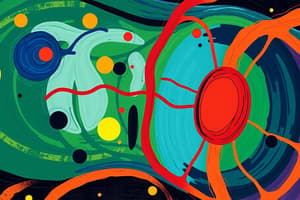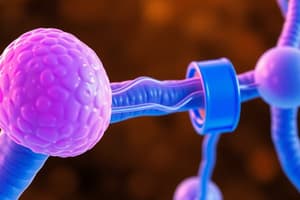Podcast
Questions and Answers
What is the initial step in turning off the signal in the cAMP second messenger system?
What is the initial step in turning off the signal in the cAMP second messenger system?
- Hydrolysis of GTP to GDP by Ga (correct)
- Reactivation of the inhibitory bg complex
- Conversion of cAMP to AMP by phosphodiesterases
- Phosphorylation of adenylate cyclase
Which of the following describes the role of phosphodiesterases in the cAMP signaling pathway?
Which of the following describes the role of phosphodiesterases in the cAMP signaling pathway?
- They stimulate the production of GTP
- They bind to the bg complex
- They activate adenylate cyclase
- They hydrolyze cAMP to AMP (correct)
Which receptors are associated with intrinsic tyrosine kinase activity?
Which receptors are associated with intrinsic tyrosine kinase activity?
- Steroid hormone receptors
- Ion channel receptors
- Receptor tyrosine kinases (correct)
- G protein-coupled receptors
What happens to Ga once GDP binds to it after GTP hydrolysis?
What happens to Ga once GDP binds to it after GTP hydrolysis?
Which hormone receptors are specifically mentioned for their action through a nuclear receptor?
Which hormone receptors are specifically mentioned for their action through a nuclear receptor?
What characterizes chronic hormone secretion?
What characterizes chronic hormone secretion?
What is the primary reason for down-regulation of hormone receptors?
What is the primary reason for down-regulation of hormone receptors?
Which of the following best explains up-regulation of receptors?
Which of the following best explains up-regulation of receptors?
What is the location of receptors for protein and peptide hormones?
What is the location of receptors for protein and peptide hormones?
What is the role of the extracellular domains of hormone receptors?
What is the role of the extracellular domains of hormone receptors?
What effect can prolonged hormone exposure have on receptor numbers?
What effect can prolonged hormone exposure have on receptor numbers?
What defines acute hormone secretion?
What defines acute hormone secretion?
Which domain of a receptor is responsible for generating second messengers?
Which domain of a receptor is responsible for generating second messengers?
What percentage of steroid hormones are typically found in a free form in the blood?
What percentage of steroid hormones are typically found in a free form in the blood?
Which type of binding proteins has high affinity but low capacity?
Which type of binding proteins has high affinity but low capacity?
What is the primary consequence of hormones being bound to transport proteins?
What is the primary consequence of hormones being bound to transport proteins?
What is the usual role of non-specialized binding proteins like plasma albumins?
What is the usual role of non-specialized binding proteins like plasma albumins?
Which hormone concentration is typically found at significantly lower levels in the blood compared to others?
Which hormone concentration is typically found at significantly lower levels in the blood compared to others?
How do binding proteins affect the hormone levels in the bloodstream?
How do binding proteins affect the hormone levels in the bloodstream?
Which of the following hormones typically has a concentration level greater than $10^{-7}M$ in the blood?
Which of the following hormones typically has a concentration level greater than $10^{-7}M$ in the blood?
What kind of bonds are primarily responsible for the binding of steroid hormones to carrier proteins?
What kind of bonds are primarily responsible for the binding of steroid hormones to carrier proteins?
Which of the following is NOT a major class of eicosanoids?
Which of the following is NOT a major class of eicosanoids?
What is one of the effects of eicosanoids?
What is one of the effects of eicosanoids?
In the patient profile, what was one of John Smith's elevated plasma eicosanoids?
In the patient profile, what was one of John Smith's elevated plasma eicosanoids?
Which treatment is NOT considered for managing John Smith's condition?
Which treatment is NOT considered for managing John Smith's condition?
What condition does John Smith likely have based on his symptoms?
What condition does John Smith likely have based on his symptoms?
Which lifestyle change could help modulate inflammation in John Smith?
Which lifestyle change could help modulate inflammation in John Smith?
What could be a potential clinical relevance of elevated eicosanoids?
What could be a potential clinical relevance of elevated eicosanoids?
Which of these drug types is categorized under DMARDs?
Which of these drug types is categorized under DMARDs?
Flashcards
Eicosanoids
Eicosanoids
A group of signaling molecules derived from arachidonic acid, known for their diverse effects on inflammation, pain, and other physiological processes.
Prostaglandins
Prostaglandins
A type of eicosanoid known for inducing inflammation, mediating pain signals, and causing fever.
Thromboxanes
Thromboxanes
A type of eicosanoid that plays a crucial role in blood clotting by promoting platelet aggregation.
Prostacyclins
Prostacyclins
Signup and view all the flashcards
Leukotrienes
Leukotrienes
Signup and view all the flashcards
HETES
HETES
Signup and view all the flashcards
NSAIDs
NSAIDs
Signup and view all the flashcards
Eicosanoid Modulation
Eicosanoid Modulation
Signup and view all the flashcards
Episodic Hormone Secretion
Episodic Hormone Secretion
Signup and view all the flashcards
Down-regulation
Down-regulation
Signup and view all the flashcards
Up-regulation
Up-regulation
Signup and view all the flashcards
Hormone Specificity
Hormone Specificity
Signup and view all the flashcards
Chronic Hormone Secretion
Chronic Hormone Secretion
Signup and view all the flashcards
Acute Hormone Secretion
Acute Hormone Secretion
Signup and view all the flashcards
Ligand-binding Domain
Ligand-binding Domain
Signup and view all the flashcards
Trans-membrane Domain
Trans-membrane Domain
Signup and view all the flashcards
Peptide or Protein Hormones
Peptide or Protein Hormones
Signup and view all the flashcards
Steroid or Amine Hormones
Steroid or Amine Hormones
Signup and view all the flashcards
Specialized Binding Proteins
Specialized Binding Proteins
Signup and view all the flashcards
Non-Specialized Binding Proteins
Non-Specialized Binding Proteins
Signup and view all the flashcards
Consequences of Binding
Consequences of Binding
Signup and view all the flashcards
Hormone Concentration in Blood
Hormone Concentration in Blood
Signup and view all the flashcards
Steroid or Amine Hormone Transport
Steroid or Amine Hormone Transport
Signup and view all the flashcards
cAMP Second Messenger System
cAMP Second Messenger System
Signup and view all the flashcards
Phosphodiesterases
Phosphodiesterases
Signup and view all the flashcards
Amplification
Amplification
Signup and view all the flashcards
PI Second Messenger System
PI Second Messenger System
Signup and view all the flashcards
Receptor Tyrosine Kinase
Receptor Tyrosine Kinase
Signup and view all the flashcards
Study Notes
Major Classes of Eicosanoids
- Prostaglandins
- Thromboxanes
- Prostacyclins
- Leukotrienes
- HETEs
Synthesis of Eicosanoids
- Arachidonic acid is a precursor for eicosanoids
- Lipoxygenase is one of the enzymes that convert arachidonic acid into other substances leading to the synthesis of leukotrienes.
- Cyclooxygenase (COX-1 and COX-2) enzymes convert arachidonic acid into prostaglandins, thromboxanes, and prostacyclins.
Effects of Eicosanoids
- Induce inflammation
- Mediate pain signals
- Induce fever
- Cause smooth muscle contraction (including uterine contractions)
- Cause smooth muscle relaxation
- Protect the stomach lining
- Stimulate platelet aggregation
- Inhibit platelet aggregation
- Cause sodium and water retention
Clinical Relevance
- Elevated eicosanoids can contribute to inflammation and pain, possibly indicating inflammatory arthritis.
- Nonsteroidal anti-inflammatory drugs (NSAIDs) and corticosteroids might be used to reduce inflammation.
- Disease-modifying antirheumatic drugs (DMARDs) such as methotrexate might be considered.
- Lifestyle modifications, such as increasing omega-3 fatty acids intake, can help to modulate eicosanoid pathways.
Synthesis of Hormone Derivatives of Tryptophan
- L-Tryptophan is a precursor to serotonin and melatonin.
- The enzymes tryptophan-5-hydroxylase, 5-Hydroxytryptophan decarboxylase, serotonin N-acetyltransferase, and hydroxindole-0-methyltransferase catalyze these transformations.
Synthesis of Hormone Derivatives of Tyrosine
- Tyrosine is a precursor for dopamine, norepinephrine, epinephrine
- The key enzymes include tyrosine hydroxylase (TH), dopa decarboxylase (DDC), dopamine beta-hydroxylase (DBH), and phenylethanolamine-N-methyltransferase (PNMT).
- The synthesis of thyroid hormones (thyroxine (T4), triiodothyronine (T3)) involves the iodination of tyrosine molecules.
Transport of Hormones
-
Peptide/protein hormones dissolve readily in plasma but may still be bound to carrier proteins.
-
Steroid/amine hormones are largely insoluble in plasma; therefore, they usually bind to carrier proteins (mainly albumin) for transport–resulting in a high bond affinity.
-
Only the unbound (free) form of hormone is physiologically active.
Binding Proteins
- Specialized binding proteins have high affinity but low capacity, and non-specialized binding proteins have low affinity but high capacity.
Consequences of Hormone Binding
- Preventing hormone action from overwhelming the system.
- Prolonging hormone effect
- Inactivation in liver or excretion in urine are delayed
- Increase total amount of hormone carrying capacity in blood
- Prevent fluctuations in active hormone levels.
- Increases reservoir of hormone available.
- Maintains equilibrium between bound and free hormone forms.
Hormone Concentration in Blood
- Peptide hormone concentrations are typically low, while steroid hormone concentrations are markedly higher, including cortisol, steroid sex hormones, with aldosterone being an exception.
Patterns of Hormone Secretion
-
Chronic secretion shows relatively constant hormone levels over time.
-
Acute secretion is a rapid response to a stimulus, with hormone levels rising and quickly returning to baseline.
-
Episodic (cyclic) secretion shows varying hormone levels at different times (for example, daily or seasonal fluctuations in some hormones).
Hormone Specificity
-
Receptors for hormones are found on or in cells, and their presence is not constant; they are degraded and replaced.
-
Down-regulation is a decrease in the synthesis of receptors, occurring with chronic hormone exposure.
-
Up-regulation is an increase in receptor synthesis, increasing cellular sensitivity to the hormone.
Receptor Location
- Protein/peptide hormones are too large or charged to pass the plasma membrane directly.
- Receptors are located on the plasma membrane in this situation.
- Extracellular domains enable interaction and binding of hormone ligands, while membrane-spanning domains anchor the receptor to the membrane.
- Cytoplasmic or intracellular domains interact with other intracellular molecules and trigger secondary messenger signalling cascades.
cAMP Second Messenger System
- Hormones bind to receptors, initiating a cascade of events culminating in an intracellular second messenger, cAMP.
- This activates protein kinases, triggering responses in the target cell.
Turning Off the Signal
-
GTP hydrolysis on Gα protein turns the signaling pathway off.
-
Phosphodiesterases catalyze the hydrolysis of cAMP to AMP.
Various Cellular Responses from cAMP
- Cellular responses from cAMP are varied and depend on the specific target cell and pathway.
- cAMP-dependent protein kinases can activate or inhibit many enzymes or processes
Amplification
- The initial binding of a hormone molecule triggers a specific cascade in a target cell.
- The cascade triggers many molecules to amplify the signaling process as it propagates through the cell and beyond.
PI Second Messenger System
- Hormones binding to surface receptors trigger a cascade of events leading to the release of second messengers.
- These trigger responses within the cell like controlling the release of various products via exocytosis.
Other Protein Hormone Receptors
- Transmembrane receptors with intrinsic tyrosine kinase activity, including receptors for insulin and growth factors, have intracellular domains.
- Receptors are activated via signal molecule dimerization and subsequent autophosphorylation of their intracellular domains.
- Activated signaling proteins transmit signals inside the cytoplasm and initiate downstream effects.
Steroid Hormone Action
- Steroid hormones diffuse directly through cell membranes, interacting with cytoplasmic or nuclear receptors.
- These actions lead to changes in gene expression and ultimately protein synthesis.
Thyroid Hormone Nuclear Receptor
- Thyroid hormones interact with nuclear receptors, directly activating specific genes and impacting RNA synthesis resulting in a thyroid hormone-specific response.
Known to Act Via cAMP
- List of hormones that use the cAMP second messenger system.
Known to Act Via cGMP
- List of hormones that use the cGMP second messenger system.
Known to Act Via Tyrosine Kinase/Phosphatase
- List of hormones that use the Tyrosine Kinase/Phosphatase cascade pathway.
Studying That Suits You
Use AI to generate personalized quizzes and flashcards to suit your learning preferences.




